The open standards for radio access networks offer options for locating network functions. These functional split options depend on network services and available transport links.
Disaggregation of the 5G Radio Access Network (RAN) opens the door to new entrants into the ecosystem. For disaggregation to work, the telecom industry defined transport interfaces between three logical nodes of the RAN. Prior to Open RAN, networks needed one transport technology: backhaul. Open RAN adds fronthaul and mid-haul transport. This openness adds flexibility, which brings on new options and decisions in network architecture.
Open RAN distributes baseband processing across the logical nodes, thereby setting the characteristics of these links, particularly for the fronthaul. 3GPP defines several options called functional splits between the nodes. Each split describes how the logical nodes interrelate to one another, and what specific activities each undertakes.
When rolling out a network, operators must choose the best functional split based on the services they provide and the economics of the available transport networks. Telecom equipment manufacturers must decide which option is best for the markets they target. No single functional split will suit all scenarios. Knowing which option to choose isn’t always straightforward. We will now review the functional split options and cover their respective merits and drawbacks, with particular emphasis on the lower level (option 7.x) splits, which are gaining most traction within the industry.
The 3GPP 5G NR architecture model
In Release 15, 3GPP, defined a new, flexible architecture for the 5G RAN, where the base station or gNodeB (gNB) is split into three logical nodes: the Central Unit, (CU), the Distributed Unit, (DU) and the Radio Unit, (RU), each capable of hosting different functions of the 5G NR stack. Figure 1 shows the Baseband Unit (BBU) — a proprietary box — dividing into the three units.
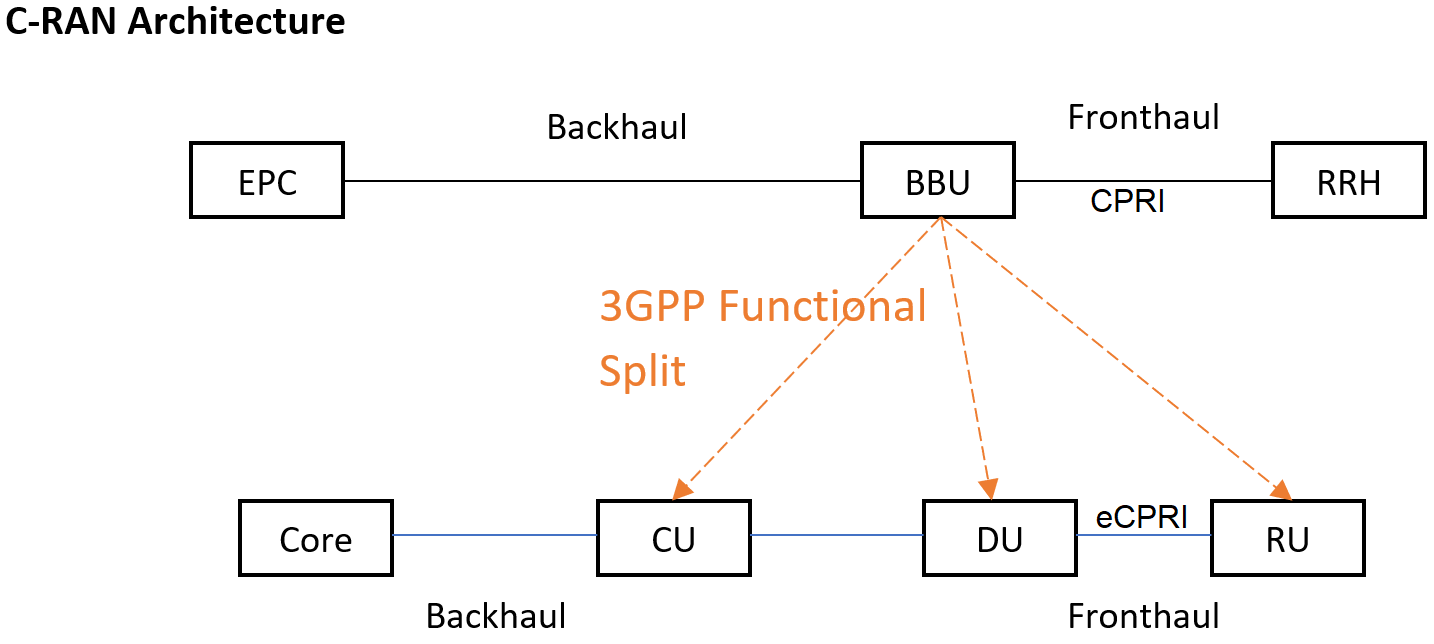
Figure 1. 3GPP’s 5G RAN architecture distributes the stack functions across three logical nodes.
Source: https://www.nctatechnicalpapers.com/Paper/2019/2019-5g-backhaul-fronthaul-opportunities-and-challenges
This architecture recognizes that transport networking availability, along with specific 5G use cases, will dictate the optimum network configuration. 3GPP specifies eight options for distributing the functionality of the 5G NR RAN stack across the fronthaul network — the functional splits.
In parallel to 3GPP’s work, several standardization bodies have been looking at the definition of the new transport interfaces — fronthaul, mid-haul, and backhaul — with the latter two particularly impacted by the choice of functional split.
The fronthaul network is key to flexible RAN deployment. The enhanced CPRI (eCPRI) standard has emerged as a successor to CPRI, which was defined for the original Centralized RAN, (C-RAN) configuration. Developed by the eCPRI Forum, this protocol makes more efficient use of bandwidth than its predecessor and is packet-based, meaning that it can be framed within Ethernet. This brings enormous advantages to the fronthaul network which, depending on the functional split, can now use Ethernet connectivity instead of relying on the availability of fiber. eCPRI is also an open interface, enabling operators to mix and match vendor equipment.
Functional Splits
When describing the functional split options, operators consider the CU and DU as a single logical unit because the splits apply to the fronthaul network. They can distribute higher Level functions of the stack between CU and DU over the midhaul network. Bit rates and latency requirements between higher layer stack functions provide more flexibility on choice of midhaul transport. In practice, the industry has settled on a split between CU and DU where CU hosts the network layer functionality (RRC) and the PDCP functionality from the Data Link Layer.
Within the eight main functional split options that 3GPP defines, option 7 further divides into sub-options 7.1, 7.2 and 7.3, discussed in more detail later.
Figure 2 shows the eight major splits, with each one offering a different trade-off between centralization benefits and fronthaul network requirements. In Option 8, all stack functionality is centralized, and this split corresponds to the original C-RAN configuration. Option 8 maximizes the benefits of centralized baseband processing enabling load-balancing and sharing of the processing capability across the RUs.
Centralization of the baseband functionality also enables virtualization of many network functions, with the software hosted on COTS servers. The result: a simplified RU because only the RF functions remain at the remote site. This small RU costs less, uses less power, and more easily fits on a tower. Operators can perform most network upgrades at the CU, requiring fewer site visits. The simplified RU can handle multiple Radio Access Technologies (RAT) further reducing the footprint of the remote mast, which must support multiple cellular generations.
By fully centralizing the functionality of the 5G RAN stack, Option 8 places the highest demands on the fronthaul network, with high bit rates and strict latency requirements. Information flows at the higher levels of the stack are less data intensive than those at the lowest, PHY, layer, which essentially converts digital bits into radio waves in the Downlink, (DL), direction and vice-versa in the Uplink (UL) direction. Functions in the PHY layer such as Cyclic Redundancy Checking (CRC), modulation, and mapping and encoding add information to the data blocks received from the higher MAC layer. Thus, progressively higher bit rates occur as the information flows towards the RF functionality.
Additionally, the time-sensitive nature of communications between PHY functionality and certain higher-level processes such as Hybrid ARQ, (HARQ), require round-trip delays as low as 5 ms.
The fronthaul requirements of Option 8 effectively limit its use to scenarios where fiber is economically justifiable, e.g., in urban areas or where operators already own it.
At the other end, an Option 1 split places all baseband processing within the RU, which becomes large, complex, and requires more power than the simplified RU of Option 8. The fronthaul network demands of functional split 1 are, however, much simpler because the entire protocol stack resides in the RU. That means more processing must occur before data can travel between RU and CU, leading to much lower bit rates and higher latency tolerances on the fronthaul network. The remaining functional split options, from 2 to 7, vary in the level of baseband processing left in the RU as opposed to being hosted in the DU/CU, as illustrated in Fig. 2.
The higher the split level, the lower the demands on the fronthaul link, balanced against diminishing benefits from centralization. Coordinated Multipoint (CoMP), for example, is a key technology in the 5G RAN, improving service at the cell edge by allowing connections to several gNBs at the same time. Split level 5 affects the CoMP’s performance. By split level 2, this capability is effectively lost.
Figure 3 shows the results of calculations of fronthaul bit rates for each functional split. Although the calculations were done on an LTE network, the findings are relevant for 5G NR. This chart shows that fronthaul bit rates are highest for the low-level split options, 7 and 8, dropping significantly for higher level splits and being fairly consistent across options 1 to 5.
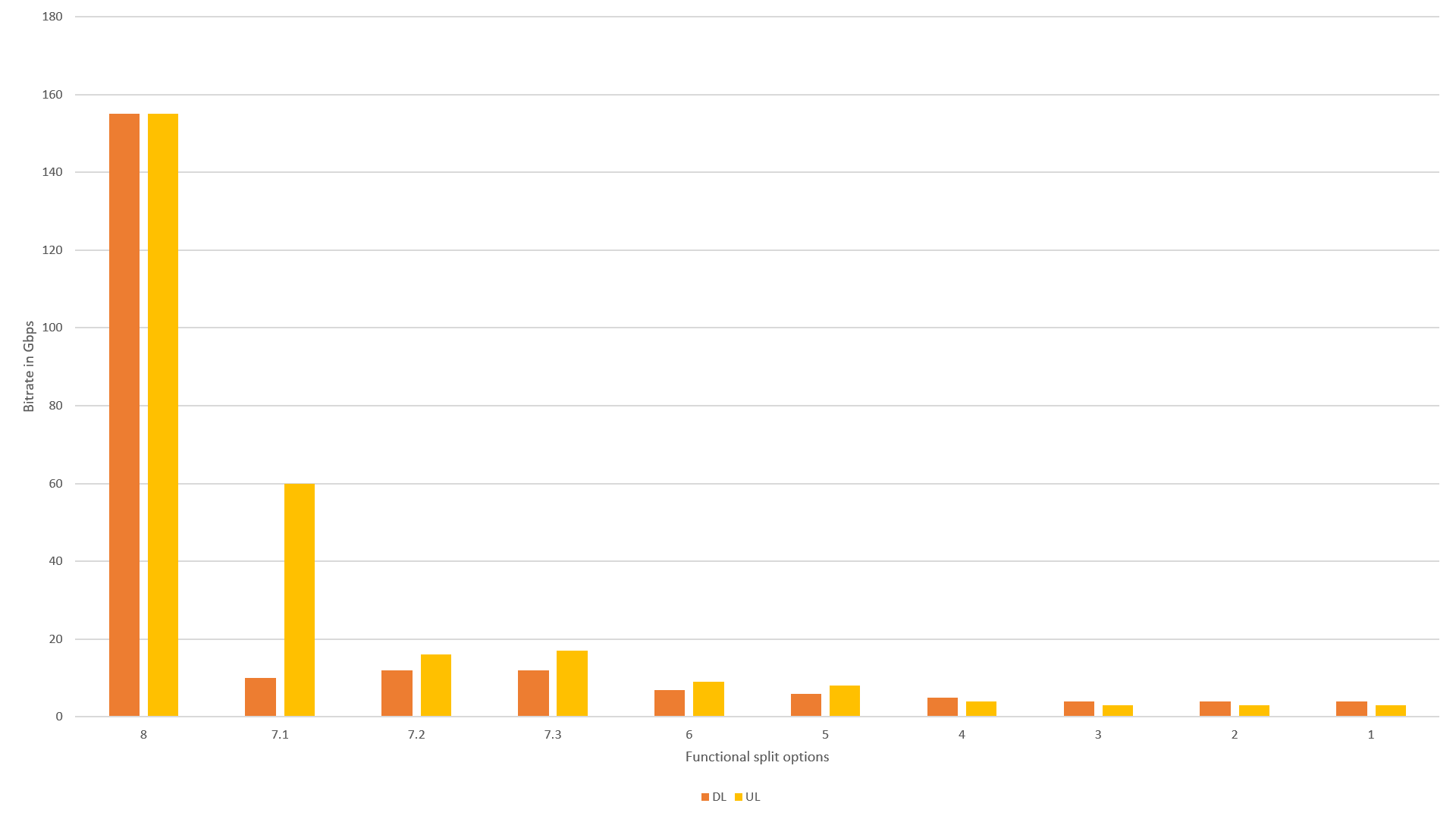
Figure 3. The Fronthaul bitrates vary significantly across the functional splits.
Source: https://ieeexplore.ieee.org/document/8479363
Fig. 3 clearly illustrates why there is so much industry interest in the Option 7, or PHY-level functional splits. Option 7 offers a good balance between RU complexity, fronthaul bandwidth, and inter-cell cooperation.
The low-level splits
The telecom industry effectively considers functional split Options 6, 7 and 8 as the low-level splits (even though they use higher numbers), with each option supporting network centralization benefits while generating different bit rates on the fronthaul network.
Option 6 splits the baseband functionality at the boundary of the MAC and PHY layers, leaving all PHY functions in the RU. This split results in a significant reduction in the fronthaul bit rate as the payload of the link consists of the transport blocks transmitted between the MAC and PHY layers. This bandwidth reduction forces a tradeoff: a reduction in the benefits achievable by a centralized pooling of baseband functionality. Option 6 limits pooling to the functions in the Data Link and Network layers, giving only 20% of the total pooling potential the remaining 80% based on PHY layer functions.
The three Option 7 functional splits, 7.1, 7.2 and 7.3 vary in the way that they divide the physical, (PHY), layer of the stack, between the DU and the RU, Figure 4.

Figure 4. The 7.X splits differ in how they allocate the PHY functionality between RU and DU.
Source: https://ieeexplore.ieee.org/document/8479363
The level 7 splits all support the key centralization benefits, including carrier aggregation, MIMO and CoMP, the main difference between them being the data-rates on the fronthaul network.
All three options leave the Fast Fourier Transformation, (FFT) functionality in the RU, significantly reducing the fronthaul bit rate. By allocating slightly more functionality, (pre-coding and resource element mapping) to the RU, Option 7.2 further reduces the fronthaul bit rate, when compared to Option 7.1. Because the resource element mapping detects unused subcarriers from the RF link, locating this function in the RU leads to a variable bit rate on the fronthaul network — Option 7.1 gives a constant bit rate. Option 7.3 is a downlink-only option and achieves further fronthaul bit rate reduction by allocating even more functionality to the RU, which becomes more complex.
All three splits provide a good compromise between centralization and fronthaul requirements, allowing relatively simple RU configurations. These options become candidates for high-capacity networks in dense urban areas. Option 7.2, however, has increasingly gained traction within the industry with its lower and variable fronthaul bit rate being compatible with the eCPRI protocol.
Which Functional Split?
There is no single, ideal functional split because different options will suit different applications. It is, however, unlikely that the industry could practically supported all eight options. To ensure scale and openness, various industry alliances are working to gain consensus on the best options to be adopted. 3GPP has recommended Option 2 for highly centralised applications such as fixed wireless access, (FWA), where cell-site coordination is not required and latency and bandwidth requirements on the transport network are relatively relaxed.
At the same time, Option 6 is being pushed by the Small Cell Forum, (SCF), as the optimal split for low-cost, low-capacity deployments). SCF, whose membership includes leading players in both the operator and equipment manufacturer communities, has developed specifications for this split known as nFAPI, (network Functional API).
Meanwhile, the equally influential O-RAN Alliance supports option 7.2 for networks with high-capacity and high-reliability requirements. This functional split enables a relatively simple RU whose size and power consumption supports network densification and enables sharing by multiple operators, facilitating the developing neutral host market. The ability of eCPRI to run on Ethernet is a significant advantage in urban areas and in indoor environments such as factories and office blocks where 5G coverage will be required.
Conclusion
The success of 5G depends upon the current industry drive towards an open RAN, supported by a transformed supply chain, where new entrants bring innovation and drive “cloud-level” economies. Disaggregation of the RAN brings more flexibility to network deployment and, potentially, enables vendor specialization, breaking the traditional, vertically integrated supply chain.
This is only possible, however, if the interfaces within the disaggregated RAN are truly open and 3GPP’s functional split definitions are a key step towards the open RAN. 3GPP’s work has been consolidated by the efforts of key industry bodies working to gain consensus on the best subset of options for practical deployment.
With this level of standardization and industry support, new entrants to the 5G eco-system can make better informed decisions when developing their products.
Olli Andersson is Senior Vice President Americas at Benetel. Andersson headed up Nokia and Nokia Bell Lab’s Innovation Centre in Sunnyvale, Calif. During his career, Andersson has led laboratories and teams of managers and engineers across the globe on a wide range of advanced telecommunications projects. Prior to joining Nokia, Andersson spent three years in South Korea heading Nokia Siemens Networks’ Smart Lab and CTO team. He holds an MBA in Strategic Management from the Helsinki University of Technology and a B.Eng in Telecommunications from the Mikkeli University of Applied Sciences.

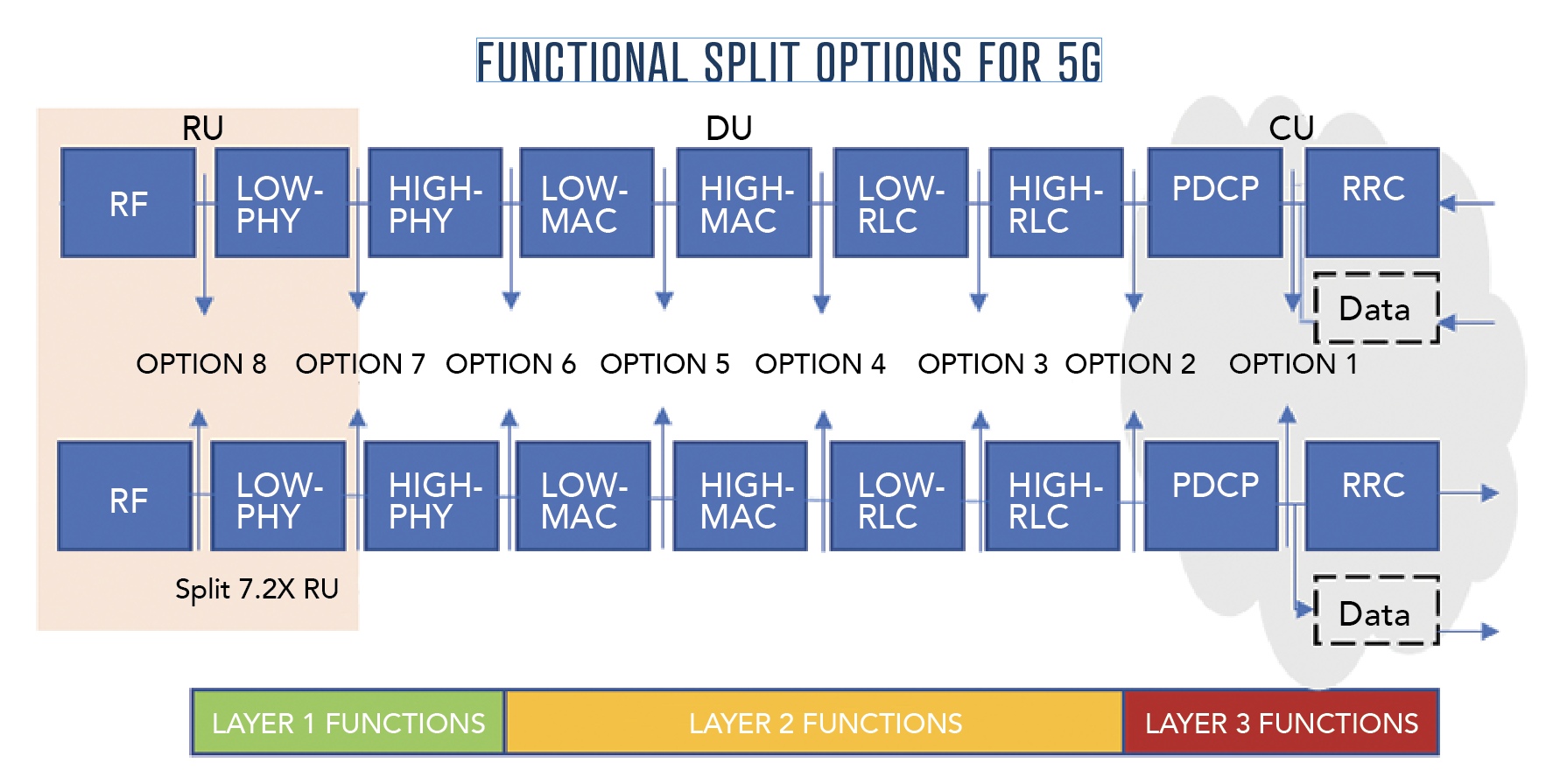
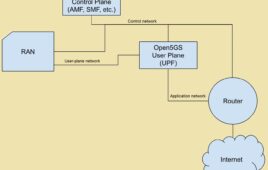
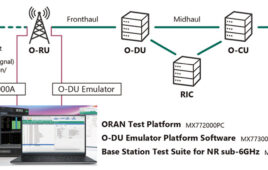
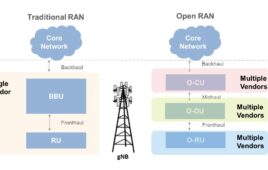

Good article and overview of the functional splits
Excellent article. Lucid, crisp and to the point.
Good article Olli – catch the important points in a neutral and simple way. Typo here though ‘The fronthaul network demands of functional split 8 are, however, much simpler because’ – should be option 1?
You are correct Steve! That was a typo that should now be corrected. Thanks for reading the article carefully through – appreciate the feedback!
Typo has been corrected.
Is there any standardization reference supporting/discussing multiple splits per unit (e.g., DU unit)?
Hi Behnam, the standards provide flexibility how the splits can be implemented by different vendors. In reality, many of the CU/DU vendors cover multiple split options inside their software.
Excellent article. Lucid, crisp and to the point. Satisfying learning experience on 3GPP functional splits.
Thanks for the article. Is the PDCP supposed to be a layer 2 function in figure 2?